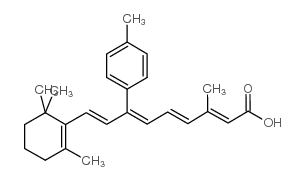160162-42-5
| Name | 3-methyl-7-(4-methylphenyl)-9-(2,6,6-trimethylcyclohexen-1-yl)nona-2,4,6,8-tetraenoic acid |
|---|---|
| Synonyms | hms3269i07 |
| Description | SR 11302 is an activator protein-1 (AP-1) transcription factor inhibitor. SR 11302 is a retinoid that specifically inhibits AP-1 activity without activating the transcription of retinoic acid response element (RARE)[1]. |
|---|---|
| Related Catalog | |
| Target |
AP-1[1] |
| In Vitro | SR 11302 (SR11302) show strong anti-AP-1 activity with selective binding with RARα and RARγ, but not with RARβ and RXRα[1]. SR 11302 (SR-11302; 1 μM) inhibits AP-1 transcription factor activity and decreases aldosterone levels by 61.9% in hypoxia-treated cells[2]. SR 11302 (SR-11302; 2 µM; 48 hours) inhibits Helicobacter pylori (H. pylori)-induced cell proliferation in adenocarcinoma gastric (AGS) cells[3]. SR 11302 (2 µM; 24 hours) inhibits H. pylori-induced expression of β-catenin and c-myc in AGS cells[3]. |
| In Vivo | SR 11302 (SR11302; low dose 0.5 mg/kg and high dose 1 mg/kg body weight; orally gavaged daily) treatment reduces the total vascular lesion number and lesion size in Vldlr-/- mice in a dose-dependent manner[4]. Animal Model: Vldlr-/- mice[4] Dosage: Low dose 0.5 mg/kg and high dose 1 mg/kg body weight Administration: Orally gavaged daily from P5 to P15 Result: High-dose from P5 to P15 reduced the total vascular lesion number by 48% and decreased the lesion size by 40%, without detectable signs of toxicity in mice, including no change in body weight. |
| References |
| Density | 1.048g/cm3 |
|---|---|
| Boiling Point | 541.567ºC at 760 mmHg |
| Molecular Formula | C26H32O2 |
| Molecular Weight | 376.53100 |
| Flash Point | 414.977ºC |
| Exact Mass | 376.24000 |
| PSA | 37.30000 |
| LogP | 7.04830 |
| Vapour Pressure | 0mmHg at 25°C |
| Index of Refraction | 1.587 |
| Hazard Codes | Xi |
|---|
